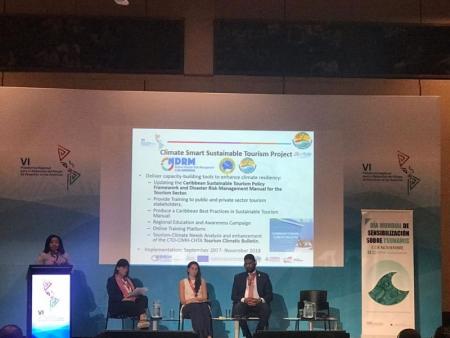
Participants at a workshop on climate smart tourism at the Regional Platform for Disaster Risk Reduction in Cartagena
By Brigitte Leoni
CARTAGENA, 26 June 2018 – Tsunamis may be rare in the Americas but they do happen as the region is highly seismic prone. A dozen earthquakes of magnitude 7.0 or greater have occurred in the Caribbean near Puerto Rico, the Virgin Islands, and Hispaniola in the past 500 years generating more than 75 tsunamis.
“We do see a general increased tsunami awareness now as the tourism sector and governments are starting to feel more vulnerable to weather related disasters,” said Amanda Charles, from the Caribbean Tourism Organization (CTO) at a session on how to reduce tsunami risk in the tourism sector held at the Sixth Regional Platform for Disaster Risk Reduction in Cartagena, Colombia last Friday.
“The tourism sector is realizing how much they can lose when disasters happen. Some are also beginning to understand that resilience can be an additional competitive advantage as well,” added Charles.
Last year, more than 30 million tourists visited the Caribbean which contributed more than $37 billion to the Caribbean economy, according to the CTO, a record breaking year for the Caribbean region despite the devastating 2017 hurricane season.
“Countries such as Anguilla and the four islands of British Virgin Islands are now Tsunami ready. St. Kitts and Nevis have annual drills, inundation and tsunami evacuation maps and Puerto Rico has developed a tsunami safety card for tourists which is accessible and distributed in hotels.
“Those are considerable progresses even if we can still see some resistance from countries too cautious to scare tourists and with too many assets located in areas vulnerable to tsunamis,” Charles said.
The Dominican Republic is among the few Islands to have integrated tsunami risks in its local prevention plans.
“In 1946, we faced a tsunami following a magnitude-8.1 earthquake off the northeast coast which killed more than 1,600 people and we learned the lesson,” said Pedro Reynado Santana Martede from the Civil Defense of the Ozama region and representative of the municipality of Santo Domingo Este, a city of nearly 900,000 people, committed to UNISDR’s Making City Resilient Campaign.
“The problem is really at community level and this is where we are focusing our major work, so coastal populations will know what to do if they observe the first signs of a tsunami.” said Martede.